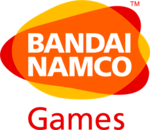Bandai Namco Entertainment
 "More Fun for Everyone" | |
|
Bandai Namco's headquarters in Sumitomo Fudosan Mita Building, Tokyo | |
Native name | 株式会社バンダイナムコゲームスエンターテインメント |
|---|---|
Romanized name | Kabushiki gaisha Bandai Namuko Entāteinmento |
Formerly |
Nakamura Seisakusho (1955–1959) Nakamura Manufacturing (1959–1977) Namco Limited (1977–2006) Namco Bandai Games (2006–2014) Bandai Namco Games (2014–2015) |
|
Kabushiki gaisha Subsidiary | |
| Industry |
Video game industry Anime Motion pictures |
| Predecessor | Namco, Bandai |
| Founded | June 1, 1955 (Namco) [1] |
| Founders | Masaya Nakamura |
| Headquarters | Minato-ku, Tokyo, Japan |
Area served | Worldwide |
Key people | Satoshi Oshita (President and CEO) |
| Products | List of Bandai Namco video games |
Number of employees |
Bandai Namco Entertainment 710 (as of April 2018)[1] Bandai Namco Studios 1066 (as of April 2018)[2] |
| Parent | Bandai Namco Holdings |
| Divisions |
Business Promotion Unit Business Management Unit |
| Subsidiaries | See list |
| Website |
bandainamcoent |
Bandai Namco Entertainment Inc. (BNEI) is a Japanese video game development company and publisher. The company also releases videos, music, and other entertainment products related to its intellectual properties (IP). The company has its headquarters in Minato-ku, Tokyo.[1]
Bandai Namco Entertainment is a wholly owned subsidiary of Bandai Namco Holdings (BNHD) and specializes in management and sales of video games and other related entertainment products, while its Bandai Namco Studios subsidiaries specialize in the development of these products. It is the core company of Bandai Namco Group's Content Strategic Business Unit (Content SBU).[3]
Bandai Namco Entertainment is the result of a merger in March 2006 between the video game operations of Namco and Bandai. Previously known as Namco Bandai Games, the company was renamed as Bandai Namco Games in January 2014.[4] In April 2015, Bandai Namco Holdings changed its gaming name from Bandai Namco Games to Bandai Namco Entertainment.
History
In early 2005, Namco Ltd. and Bandai Co. Ltd. announced plans to combine their operations.[5] The merger took effect on September 29 of that same year. For the first six months, both companies stayed intact under the umbrella of the newly created Namco Bandai Holdings.
On March 31, 2006, the video games division of Bandai was merged into Namco which in turn became Namco Bandai Games.[6][7] Namco Hometek and Bandai Games had already merged on January 2, 2006 to form Namco Bandai Games America in the United States.[8][9]
On April 1, 2008, Banpresto's video game operations were absorbed by Namco Bandai Games.[10] On April 1, 2009, Bandai Networks, Namco Bandai's mobile phone business, was dissolved and absorbed into Namco Bandai Games.[11]
In 2010, Namco Bandai Games entered the Guinness World Records for being the company that released the most TV commercials for the same product, a Nintendo DS game called Solatorobo: Red the Hunter. They created 100 versions of the ad as the game consists of 100 chapters.[12]
In early 2011, Namco Networks was absorbed to Namco Bandai Games America, effectively consolidating Namco Bandai's American console, handheld and mobile video game development operations.[13]
On April 2, 2012, Namco Bandai Games spun off its development operations into a new company called Namco Bandai Studios. The new company was spurred by Namco Bandai's interest in faster development times and tighter cohesion between disparate development teams. It will comprise approximately 1,000 employees, who are already part of Namco Bandai.[14]
In March 2013, Namco Bandai Games established two new game studios. The first, Namco Bandai Studios Singapore, will be Namco Bandai's "leading development center" in Asia and develop game content for the Asia Pacific. The second studio, Namco Bandai Studios Vancouver, will work on online social games and game content development for North America and Europe, and will be established within The Center for Digital Media (CDM).[15] In July 2013, Namco Bandai Partners (NBP), which used to oversee the PAL distribution network since September 2012, merged with Namco Bandai Games Europe (NBGE) in order to push distribution and publishing into one entity, Namco Bandai Games Europe (NBGE).[16]
On January 25, 2014, Namco Bandai Games and Namco Bandai Studios announced that the companies would be known worldwide as Bandai Namco Games and Bandai Namco Studios, respectively. The change is intended to unify the brand internationally in order to increase the "value" and "appeal" of the name.[4] In December 2014, the company announced in a press release that the full company name will be changed to Bandai Namco Entertainment on April 1, 2015.[17]
On April 1, 2018, the amusement machine business division of Bandai Namco Entertainment was transferred over to sister company Bandai Namco Amusement. [18][19]
Organization
Branches
Bandai Namco Entertainment (BNEI), plays the role of expanding the content business, while Bandai Namco Studios (BNSI) plays the role of creating content. Both companies cooperate to provide products and services around the world.
Bandai Namco Entertainment

Bandai Namco Entertainment (BNEI) is a core company of the Content Strategic Business Unit (Content SBU) of Bandai Namco, and is responsible for all aspects of Bandai Namco Group’s content business, from creation to sales. However, Bandai Namco Entertainment spun off its video games and related entertainment development to Bandai Namco Studios in April 2012. As such, Bandai Namco Entertainment is currently responsible for managing, publishing, and marketing of already developed content, not only from Bandai Namco Studios but from third-party developers as well.[14]
In addition to its core publisher operations in Japan, Bandai Namco Entertainment publishes content worldwide through different entities. Bandai Namco Entertainment America manages operations and handles publishing across North America and oversees operations of Bandai Namco Entertainment Brazil, which operates and handles publishing in Brazil. Bandai Namco Entertainment Europe manages and oversees operations and handles publishing across EMEA, and has branches in France, Italy, Greece, Romania, the Nordic countries, Portugal, Spain, Germany, United Kingdom, Australia, New Zealand, Bandai Namco Entertainment Asia manages and oversees operations and handles publishing across Asia (except Japan), and has branches in Malaysia, Singapore, Korea, Philippines, Taiwan and Hong Kong.
Bandai Namco Studios

Bandai Namco Studios (BNSI) functions as the core video game development studio of Bandai Namco Entertainment. In addition to its video game development operations, Bandai Namco Studios also work on other entertainment content such as video and music, related to its video game IPs.
In addition to its core development studio in Tokyo, Japan, Bandai Namco Studios has development operations in Singapore, which develops game content for the Asia Pacific, and Vancouver, British Columbia, Canada (established within The Center for Digital Media), which develops online social games for North America and Europe.[15]
Key people
- Satoshi Oshita, President, representative director[1]
- Shin Unozawa, Executive vice president, representative director
- Kazuya Kiyoshima, member of the board, managing director
- Hitoshi Hagiwara, member of the board, managing director
- Fumiya Takeno, member of the board
- Koichi Honda, member of the board
- Makoto Asanuma, member of the board
- Masaaki Tsuji, member of the board (part-time managing director)
- Masaya Nakamura, founder
Surge label
Just prior to the release of Afro Samurai at the end of 2008, the company announced the Surge publishing label.[20] The new label was an attempt at creating a separate identity for the company, aimed at a Western audience desiring more mature themes in game content, such as Naruto Uzumaki chronicles [21] Following Afro, early press materials indicated that Dead to Rights: Retribution and Splatterhouse would also be released under the Surge label, but neither game ultimately did; both were released with a retro Namco label instead to reflect the series' legacy.
Games
References
- 1 2 3 4 "Corporate Overview". 'Bandai Namco Entertainment. Retrieved September 1, 2018.
- ↑ "About". Bandai Namco Studios. Archived from the original on 2017-08-19. Retrieved 18 August 2017.
- ↑ "Strategic Business Units". Bandai Namco. Archived from the original on 2014-04-30. Retrieved 2 February 2014.
- 1 2 Goldfarb, Andrew. "Namco Bandai Changing Name to Bandai Namco". IGN. Retrieved 2 February 2014.
- ↑ Feldman, Curt. "Bandai, Namco to merge". GameSpot. Archived from the original on 2014-04-08. Retrieved 2 February 2014.
- ↑ "株式会社バンダイナムコホールディングス 2005年度事業報告書" (PDF). Namco Bandai Holdings. 2006. Archived from the original (PDF) on 2015-09-05. Retrieved August 6, 2017.
- ↑ Karlin, David. "Bandai and Namco Finalize Merger Details". 1UP.com. Archived from the original on 2014-03-12. Retrieved 2 February 2014.
- ↑ Adams, David. "Namco, Bandai Complete North American Merger". IGN. Retrieved 2 February 2014.
- ↑ "Namco and Bandai complete merger in North America". GameSpy. 4 January 2006. Archived from the original on 26 January 2014. Retrieved 2 February 2014.
- ↑ Spencer (9 November 2007). "Banpresto absorbed by Namco Bandai". Siliconera. Siliconera. Archived from the original on 23 February 2014. Retrieved 2 February 2014.
- ↑ "KatanaXtreme.com – Namco Bandai Games Inc. to Take Over Bandai Networks Co., Ltd". Archived from the original on 2009-01-23. Retrieved 2008-12-10.
- ↑ "Most TV commercials for the same product (8 hrs) – regional/Free-to-air". Guinness World Records. Archived from the original on 2014-02-03. Retrieved 2 February 2014.
- ↑ "Namco Bandai Games America/Namco Networks merger". Games Industry International. Archived from the original on 19 February 2014. Retrieved 2 February 2014.
- 1 2 Gilbert, Ben (10 February 2012). "Namco spins off internal dev studios into 'Namco Bandai Studio'". Famitsu. Joystiq. Archived from the original on 19 February 2014. Retrieved 2 February 2014.
- 1 2 Romano, Sal (10 April 2013). "Namco Bandai opening Singapore and Vancouver studios". Gematsu. Archived from the original on 18 February 2014. Retrieved 2 February 2014.
- ↑ Long, Niel (1 July 2013). "Namco Bandai completes merger of publishing and distribution businesses". Edge Magazine. Archived from the original on 4 February 2014. Retrieved 2 February 2014.
- ↑ 2014-12-16, Bandai Namco Games changing name to Bandai Namco Entertainment, Gematsu
- ↑ https://www.bandainamco.co.jp/cgi-bin/releases/index.cgi/file/view/6091?entry_id=5509
- ↑ https://www.bandainamcoent.co.jp/english/history/
- ↑ McWhertor, Michael. "Namco Bandai Needs Westerners, Plans "Surge"". Kotaku. Archived from the original on 2010-12-26. Retrieved 2010-11-27.
- ↑ Sheffield, Brandon. "Q&A: Namco Bandai's Iwai Talks Tricky Topics In Western Markets". Gamasutra. Archived from the original on 2010-11-13. Retrieved 2010-11-27.
External links
| Wikimedia Commons has media related to Namco Bandai. |
